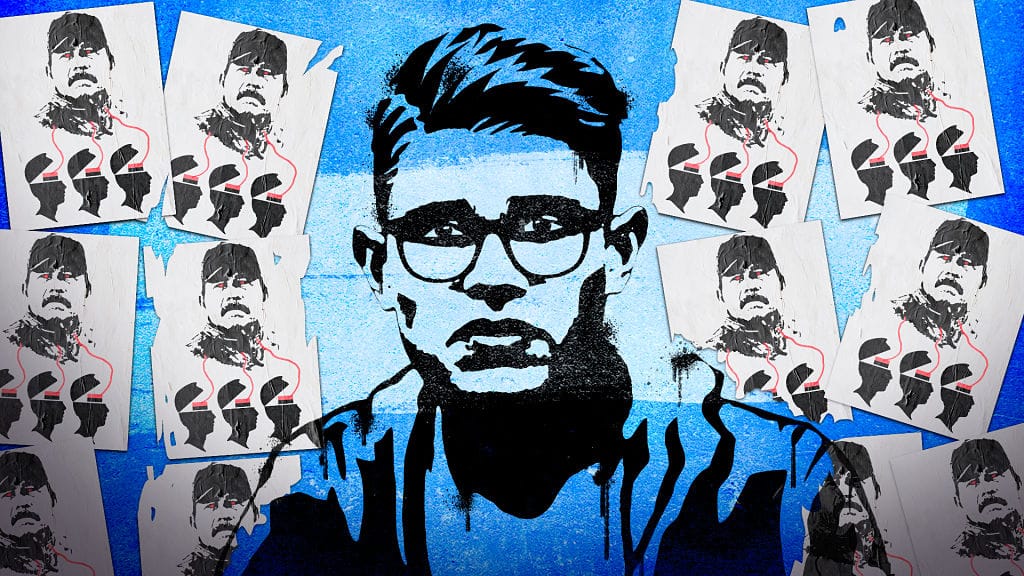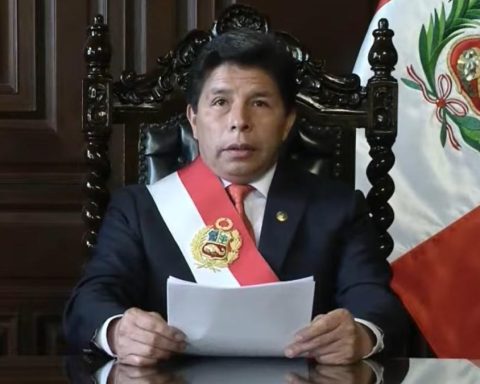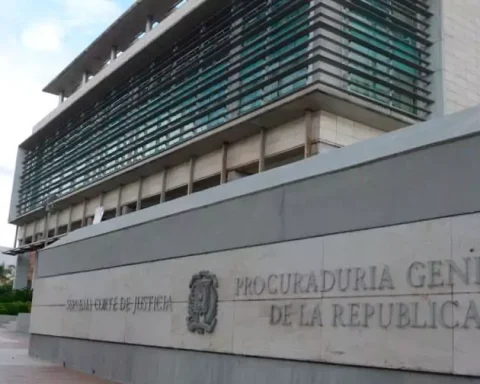Lesther Alemán enters the room where he will be judged walking slowly and with his eyes a little lost. He looks very weak and in poor health, even though he just turned 24. They say that a few minutes before he found out that he will have to face this trial, accused of a crime —“undermining national integrity”— plausible only for the laws that the regime that governs Nicaragua hastened to sanction in May of last year, before to speed up the arrest of his main opponents. Lesther, imprisoned and incommunicado for more than 200 days in the prison they call El Chipote, manages to mutter a “I’m innocent!” before Judge Nadia Camila Tardencilla silences him, obeying a request (which seems more like an order) from the prosecutor of the trial, a judicial official who —they say— is a fervent adherent to the governing Sandinismo.
That Thursday, February 3, almost seven months after being torn from the arms of his mother, Lesbia Alfaro, by a police patrol, the leader of the Nicaraguan University Alliance (AUN), who had dared to stand up to President Daniel Ortega in April 2018, he is expected to be found guilty. And days later, Judge Tardencilla dictates the inevitable sentence: 13 years in prison. In other words, Lesther Alemán will remain locked up until he is 37 years old, the same years that Ortega had when he first assumed the management of the country in the 1980s.
Today, at 76 years of age, the former Sandinista guerrilla is far from those dreams of youth. Almost as far as accepting that young people like Lesther have the right to speak and disagree with him. Even to stand up to him and call him a “murderer” at a dialogue table, as Alemán did in April 2018. Closing eight private education institutions has the clear objective of further controlling these dissenting voices in educational centers. For Ortega and his profoundly authoritarian vision, the Lesther factor represents the dissenting voice that must be silenced in order to continue controlling the government, power and the life of every Nicaraguan citizen.
(VIDEO) Lesther Alemán became the voice of thousands in #Nicaragua: A student confronted Daniel Ortega and warned him that the table is to discuss his departure from power. He watches his intervention >> https://t.co/4r4uxtefE5 #SOSNicaragua pic.twitter.com/Jw6lGeSWat
– THE PRESS Nicaragua (@laprensa) May 16, 2018
For the Sandinistas who remain loyal to Ortega, and there are not a few, the young Social Communications student is a “traitor to the country” who deserves jail and many other opprobriums, such as psychological torture, intense interrogations and almost no communication with his relatives and lawyers to whom he has been subjected in prison, as denounced today by his mother, human rights organizations and AUN itself.
The laws dictated by the Ortega regime prefer to hide it behind more pompous and imprecise accusations (“conspiracy to undermine national integrity”). But the crime committed by Lesther, his partner Max Jerez (also sentenced to 13 years on February 21) and the entire university movement that led the 2018 protests is that of having allowed themselves to speak. To take to the streets and say that they do not agree that a single man, screwed to power for 15 years, continues to define the destiny of 6.6 million Nicaraguans.
#Release | Lesther and Max send a lot of strength and hope to the Nicaraguan people. Similarly, they appreciate all the campaigns, efforts, messages and prayers for their freedom and that of all political prisoners. #There is still hope #SOSNicaragua pic.twitter.com/jqnOokrtmt
– AUN (@AUNNicaragua) January 3, 2022
Almost four years ago, during the demonstrations and the subsequent repression, the students achieved a feat: twisting the will of Ortega, a leader accustomed to not backing down. The president had to not only withdraw his intended reform of the social security system but also call for dialogue that finally crossed his path a 20-year-old man, wearing a black shirt and a neckerchief in the colors of the Nicaraguan flag, who It showed him a face of the country that he is not willing to accept: the opposition to his dictatorial ways. His response since then has been to persecute to the point of silencing this student movement and the places where it nests: the universities. This explains his last blow: the confiscation of eight of these.
the great confiscation
“Obedient universities, or nothing”, described Sergio Ramírez, Ortega’s former vice president in the 1980s. The writer, exiled in Spain, thus targeted the February 2 decree that outlawed 14 organizations, including five private universities. The measure, which generated a cocktail of impotence, indignation and uncertainty in thousands of students who were to begin their year of study that same week, can be read as the final blow of the Sandinista government against private universities. The first five canceled were the Polytechnic University of Nicaragua (Upoli), the Catholic University of the Dry Tropics (Ucatse), the Pablo Freire University (UPF), the Nicaraguan University of Humanistic Studies (Uneh) and the Nicaraguan Popular University (Uponic). Three more were added to them: the Hispano-American University (Uhispam), closed in December; and the Nicaraguan Technological (UTN) and the Santo Tomás de Oriente y Mediodía (USTON), whose cancellations were approved on February 23 by the National Assembly —which controls an overwhelming Ortega majority—. Of all of them, the Upoli is the one that has the greatest meaning for those who resist the regime: it was the hotbed of the 2018 demonstrations.
The National Assembly today approved the Legislative Decree for the Cancellation of the Legal Personalities of the civil associations Nicaraguan Technological University (UTN) and Santo Tomas de Oriente y Mediodía University (USTON) Granada. pic.twitter.com/Y57qik3nSC
– Nicaraguan National Assembly (@AsambleaNi) February 23, 2022
The official explanation is that the legal entities of the universities were canceled for being “not very transparent in the administration of the funds”, since the Ministry of the Interior (Migob) does not know “the way in which they were executed and if it was in accordance with their objectives and purposes for which the National Assembly” granted them. But apart from the regime’s versions, almost everyone agrees that it is an act of confiscation, which is prohibited by the country’s Political Constitution. To give a little “legality” to this outrage, the National Assembly created, in the properties of some of the closed ones, four state universities under the direct control of the Ortega regime. That is to say, without any type of constitutionally enshrined university autonomy, as denounced by the Union of Universities of Latin America and the Caribbean (Udual), the largest and oldest university network in the region.
#NOW #Nicaragua | With the presence of Members of the National Council of Universities and special guests, the solemn act of inauguration of the authorities of the new National Polytechnic University (UNP) begins. pic.twitter.com/aeViuDgIUb
– TN8 Nicaragua (@canaltn8) February 10, 2022
According to your calculation CONFIDENTIAL digital mediumbased on the few data that there is in Nicaragua on university enrollment, there are about 18,000 students affected by this measure by Ortega, who thus received a new blow after many of them were expelled from public universities in 2018 for having protested against the government.
That photo of the Upoli in May 2018, with some 500 students entrenched as a solitary focus of resistance to the “dialogue” called by Ortega, is becoming sepia. Now, many see that this image will be transformed into that of other young people patrolling the building, although raising very different flags: that of the National Union of Nicaraguan Students (UNEN), the university arm of the Sandinista Front.
“All the actions undertaken by the Nicaraguan State, led by the Ortega-Murillo regime, seek to nullify the participation of citizens in public affairs, eradicate any critical thought, for which we urge the national and international educational community to show solidarity and continue defending academic freedom, university autonomy, human rights and democracy,” denounced in a statement the University Coordinator for Democracy and Justice (CUDJ), a youth organization that has been resisting Ortega’s offensive against universities.
Also victims of the nationalization of the universities are their rectors, who now bear the weight of the accusing finger of Sandinismo, always fond of persecuting and imprisoning its opponents. For this reason, Adrián Meza, from Paulo Freire, decided to go into exile in Costa Rica, from where he spoke to the independent Nicaraguan press and accused the Ortega government of wanting to manage education in the country with political criteria, as he told CONFIDENTIAL: “They are not academic criteria, they are not educational criteria, but rather they are criteria of political subjection.”
Something similar was stated in the same medium by the former rector of the American University (UAM), Ernesto Medina: “Right now those who are in charge of education are political commissioners, political agents. People who are solely concerned with ensuring that in all stages of the (educational) system people only obey the orders of the government officials.”
Moving from critical thinking to unique thinking seems to be the goal of this latest blow by the regime against the universities. A fact that has a precedent in Nicaragua, contributing even more to historical parallels that Ortega has become accustomed to tracing with the Somoza dictatorship. In 1946, as the newspaper La Prensa recalled, Anastasio Somoza García closed the Central University in revenge for the opposition he had received from those cloisters against his re-election.
Students have always made autocrats uncomfortable in Latin America. The Tlatelolco Massacre in Mexico (1968) and La Noche de los Lápices in Argentina (1976) are just two examples that what Ortega is doing now in Nicaragua repeats parameters of the worst dictatorships. And the figure of Lesther Alemán, the young man who today appears defeated by his Sandinista executioner, can become the flag that a new generation of Nicaraguans raises to fight against the abuses of a family entrenched in power. The same thing that Daniel Ortega himself once did under the symbol of another victim of the harshest repression in Nicaragua: Augusto César Sandino.
* Member of the editorial board of Connectas

















